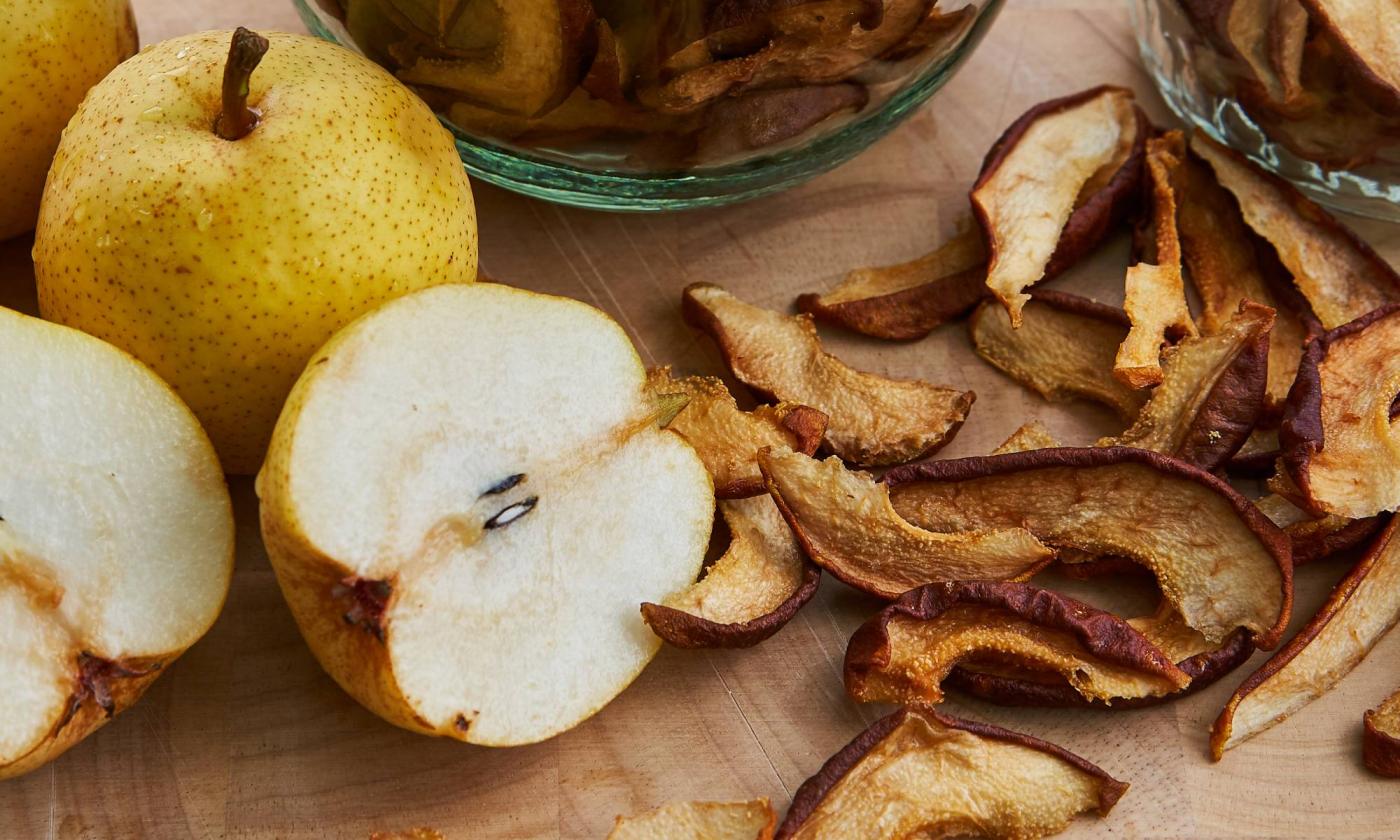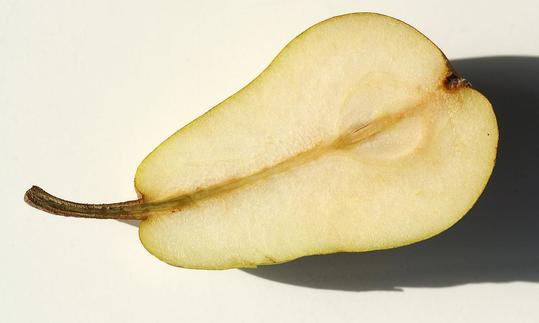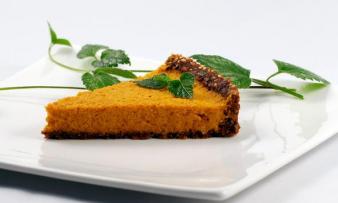Table of contents
Dried pears are a healthy snack for in between meals, especially in organic quality. Only gently dried and raw .
Use in the kitchen
Dried organic pears are ideal for refining breakfast, e.g. in porridge or muesli ( pea muesli ). Dried pears are mostly used for desserts and baked goods, such as fruit bread (pear bread), biscuits, muffins or cakes. Dried pears also taste good in salads (e.g. with field lettuce and tomatoes ) or pasta with white cabbage , dried tomatoes , chestnuts and pine nuts . When pears are dried, they take on a brownish color. Sulphurized pears do not have a brownish color. However, sulfur is not absolutely necessary for the taste and shelf life, it only serves to "improve" the appearance.
Dried fruits, such as dried pears, apples , figs , apricots , plums and mangos , should only be consumed in small portions, as they contain a lot of sugar (even if it is naturally occurring). They are rarely of raw food quality, meaning they are no longer "raw".
Dried pear slices (pear chips) and pear wedges are commercially available. Whole dried pears are a speciality. Since they are not cut open, they only lose about three quarters of their weight. Drying is mainly done in traditional drying ovens that are fire-powered. After boiling in water (8-10 hours), they are dried for 2-3 days in the drying chamber. At the end of the day, the pear is brown and very shriveled up due to the loss of water. The inside, however, remains soft and fleshy. The taste is very intense. 10
Making your own dried pears
Dried or dehydrated pears are easy to make yourself. Ripe organic pears of different varieties are suitable for this. The harder (lower water content) and tastier the variety, the better they are suited to drying.
After washing, the pears should be quartered (small varieties can also be halved) and the stem and core removed. Peels should not be peeled as they contain important secondary plant substances. For pear chips, the pears can be sliced with the core or cut out after cutting. The prepared pear pieces or pear chips can be sprinkled with lemon juice (reduces browning).
For raw pear slices, it is best to use a dehydrator (food dehydrator) and set the temperature below 42 °C. Different dehydrator models usually have their own instructions (time and temperature) for each fruit. Dehydrators are also very energy efficient, as fruits need many hours to dry. Drying can take 10 to 12 hours, depending on the water content of the pear variety.
Alternatively, you can use the oven with the convection function. To do this, place the pears on a baking tray lined with baking paper. It is more energy efficient to put several trays in the oven at once. When drying in the oven, it is necessary to leave a small gap open so that the moisture can escape. You will often find instructions with drying temperatures of 70 °C. If you want to dry as gently as possible, we recommend temperatures of 40-50 °C. If you cannot regulate the oven temperature precisely below 50 °C, it is advisable to set the oven to the lowest setting (mostly starts below 50 °C, but without a display). Heat also escapes through the open gap and you can assume that the temperature will reduce somewhat as a result.
Vegan recipe for pear jam made from dried pears
Ingredients (for 4 people): 100 g dried pears, 250 ml pear juice (alternatively apple juice ), pinch of cinnamon , pinch ofvanilla powder .
Preparation: Put the pears and pear juice in a bowl, mix and leave covered for about 2 hours. Puree the mixture finely with a blender. Season with cinnamon and vanilla powder. The shelf life of this unheated jam is limited, which is why we recommend using it up within a few days.
Vegan recipes with dried pears can be found under the note: " Recipes that have the most of this ingredient ".
| Not only vegans or vegetarians should read this: Vegans often eat unhealthily. Avoidable nutritional mistakes . |
Purchasing - Storage
You can find pear wedges, pear slices (pear chips) and dried, whole pears in stores. Major retailers such as Coop , Migros , Denner , Volg , Spar , Aldi , Lidl , Rewe , Edeka , Hofer and Billa usually have these (seasonally) in some form in their range, occasionally also in organic quality. The dried pears available in stores are often sulphurized (e.g. sulphur dioxide). This keeps them light in color and extends their shelf life. For health reasons, unsulfured pears should be preferred. Unsulfured organic pears are available in organic supermarkets ( Denn's Biomarkt and Alnatura ), organic shops or health food stores. Whole dried pears (dried pears) can be found in gourmet shops, organic and farm shops or online.
The term "raw food" is not regulated by law, which is why there are no state certification bodies for it - unlike organic production. You have to be careful with the terms "raw" or "sun-dried" because producers do not always take the temperature restrictions (approx. 42 to 45 °C for "real" raw food) seriously. The pears are often dried at over 60 °C (see Industrial Production).
The availability of dried pears varies depending on the size of the store, catchment area, etc. Our recorded food prices for the DA-CH countries can be found above under the ingredient image - and by clicking on them you can see their development at different suppliers.
Storage tips
Properly dried pears can be kept for several weeks to months. Screw-top jars, cans or other sealable containers are suitable for storing dried pears. In any case, they should be stored in a dark, cool and airtight place.
Ingredients - Nutritional values - Calories
Fresh pears consist of 84% water and are one of the low-calorie fruits with around 57 kcal/100g. In dried form, the nutrients and the calorie content increase to 262 kcal/100g, of which around 62% is sugar. The remaining moisture is around 27%. 1
Dried pears (organic?) contain about 533 mg/100g potassium , a little more than dried apples (450 mg/100g), but less than dried mangos (835 mg/100g) and dried apricots (1162 mg/100g). Sun-dried tomatoes (3427 mg/100g) and dried spices such as coriander leaves (4466 mg/100g) have particularly high potassium levels. 1 Potassium regulates the osmotic pressure in the cells and has a balancing effect on the water balance.
Vitamin K is also well represented at 20 µg/100g, which covers 27% of the daily requirement. Dried peaches and dried figs have similar vitamin K values (16 µg/100g). Dried herbs, such as dried wild garlic (2625 µg/100g), contain particularly high levels of vitamin K. 1
Dried pears also contain large amounts of manganese . At 0.33 mg, 100 g cover about a third of the daily requirement, similar to dried peaches. Combined with hazelnuts (6.2 mg/100g) andpumpkin seeds (4.5 mg/100g) you can easily achieve the optimum. 1
The complete ingredients of dried pears (raw), the coverage of the daily requirement and comparison values with other ingredients can be found in our nutrient tables. In the article Nutrients explained you will get a detailed insight into the topic.
Health effects
Are dried pears healthy? Dried pears contain secondary plant substances such as flavan-3-ols, phenolic acids and chalcone (dihydrochalcones). The phenolic profile is comparable to dried apples , which still contain flavonols. Dried fruits such as raisins , cranberries , figs , dates and apricots contain a broader spectrum and higher levels of phenolic compounds than pears and apples. 11
Dried fruit is good for the digestive tract due to its high fiber content and keeps you full longer than other snacks. Dried pears contain 7.5 g of fiber per 100 g, which covers 30% of the daily requirement. 1 However, only 20-30 g of dried fruit per day is recommended because it contains a lot of sugar. 12 Compared to fresh fruit, blood sugar rises more quickly.
Do dried pears still contain vitamins? By gently removing water, minerals and trace elements are largely retained and are more concentrated. The vitamin content depends on the drying temperature (see industrial production).
Dangers - Intolerances - Side effects
Eating pears can cause allergic reactions. In northern Europe, this usually affects people who also have allergic reactions to birch pollen. Local symptoms such as a scratchy mouth and throat occur 5-15 minutes after consumption. The allergen involved can be rendered ineffective by cooking beforehand. In Mediterranean countries, however, an allergic reaction to pears occurs as a cross allergy to peaches. The possible symptoms are far more serious in this form, with stomach pain, vomiting or life-threatening conditions. 5
Ecological footprint - animal welfare
The ecological footprint of dried pears, as with fresh pears, depends on the type of cultivation, regionality and also the type of drying. Regional, raw pears have a similar value of 0.3 kg CO 2 eq/kg to regional apples or grapes . 6 Imported pears from other continents, on the other hand, do rather poorly in the assessment of the climate effect due to the high amount of CO 2 during transport by ship (from South Africa). 7 To illustrate: fresh apricots have a CO 2 footprint of 0.79 kg CO 2 eq/kg, dried ones come in at 2.24 kg CO 2 eq/kg. 14
The amount of water required to produce 1 kg of pears is 922 liters. Since we did not find any values for dried pears, we will show the difference in water consumption using apples: fresh apples require about 822 l/kg, dried apples 6847 l/kg. 8
Studies show that certain drying methods, such as convection air dryers, have higher energy consumption and emissions than microwave hot air dryers. 9 Using solar energy for drying can also reduce their emissions.
In order to keep the amount of emissions as low as possible, it is best to buy regional, sun-dried pears from organic farming . This type of farming does not use chemical fertilizers or pesticides, which play a major role in conventional agriculture.
Worldwide occurrence - cultivation
The origin or gene center of the current pear genus ( Pyrus ) is not clearly established. It is believed to have originated in the mountainous region of western China. The subsequent domestication then split in both directions of the mountain range - towards the east and west. Evidence of pear cultivation has been found in China, as well as in Asia Minor, the Middle East, the Caucasus and Central Asia. Of the 23 catalogued wild pear species, all are native to Europe, the temperate zones of Asia and North Africa. 3
Worldwide, the pear is the third most important fruit variety in the temperate climate zone after grapes and apples. 2 According to FAOSTAT , 26.32 million tons of pears were produced worldwide in 2022. The main producing countries are China (19.26 million tons), the USA (584,230 tons), and Argentina (566,227 tons). 4
For information on cultivation and harvesting, see Pear, raw (organic?) .
Industrial production
Pears are dried in industrial convection dryers, microwave or infrared dryers or combinations of these. 9 The traditional drying method involves placing the pears in fire-fired drying ovens (traditional dehydrator), 10 or drying them directly in the sun in hot areas (eg Portugal).
During drying, the proteins and minerals hardly change. The provitamin A and the B vitamins are largely retained. At a drying temperature of 70 °C, the vitamin C content decreases massively. The highest production quality is achieved with gentle drying below 40 °C (max. 50 °C). However, the drying temperature in many dryers is 60 °C (convection dryers, traditional drying houses) and in industrial belt dryers 65 °C. 13
Further information
Dried pears are mostly produced from the European cultivated pear ( Pyrus communis L.). This belongs to the pear genus ( Pyrus ), which contains 22 species and other varieties. These can pollinate each other and form hybrids. 2
Other well-known species are the Chinese pear ( Pyrus calleryana ' Chanticleer ' ) or the Pyrus pyrifolia Nakai, known as the Nashi pear .
The pear belongs to the pome fruit family (Pyrinae) in the rose family (Rosaceae). Other well-known pome fruits are: apples ( Malus ), chokeberries ( Aronia ), quinces ( Cydonia ) and medlars ( Mespilus ).
Alternative names
Alternative names are Dörrbirnen, Kletzen (Kletze) and Hutze (Hutzle). The English name is dried pears. Dried pears are called "Kletzen" in southern Germany and Austria. In Austria they are added to Kletzen liqueur.











Comments